Energy Distribution of Optical Radiation Emitted by Electrical Discharges in Insulating Liquids
Abstract
1. Introduction
2. Method of Measuring Optical Spectra
3. Measurement Results
4. Optical Radiation Energy
5. Conclusions
Funding
Conflicts of Interest
References
- Kunicki, M. Variability of the UHF signals generated by partial discharges in mineral oil. Sensors 2019, 19, 1392. [Google Scholar] [CrossRef] [PubMed]
- Wotzka, D.; Koziol, M.; Nagi, L.; Urbaniec, I. Experimental analysis of acoustic emission signals emitted by surface partial discharges in various dielectric liquids. In Proceedings of the IEEE 2nd International Conference on Dielectrics (ICD 2018), Budapest, Hungary, 1–5 July 2018. [Google Scholar]
- Mukhtaruddin, A.; Isa, M.; Noor, M.M.; Adzman, M.R.; Ain, M.F. Review of UHF detection of partial discharge experimentation in oil-filled power transformer: Objectives, methodologies and results. In AIP Conference Proceedings; AIP Publishing LLC: Melville, NY, USA, 2018; Volume 2013. [Google Scholar]
- Meitei, S.N.; Borah, K.; Chatterjee, S. Modelling of Acoustic Wave Propagation Due to Partial Discharge and Its Detection and Localization in an Oil-Filled Distribution Transformer. Frequenz 2019, 74, 73–81. [Google Scholar] [CrossRef]
- Dincer, S.; Duzkaya, H.; Tezcan, S.S.; Dincer, M.S. Analysis of Insulation and Environmental Properties of Decomposition Products in SF6-N2 Mixtures in the Presence of H2O. In Proceedings of the IEEE International Conference on Environment and Electrical Engineering and IEEE Industrial and Commercial Power Systems Europe, EEEIC/I and CPS Europe, Genova, Italy, 11–14 June 2019. [Google Scholar]
- Graczkowski, A.; Gielniak, J.; Przybyłek, P.; Walczak, K.; Morańda, H. Study of the Dielectric Response of Ester Impregnated Cellulose for Moisture Content Evaluation. In Proceedings of the 23rd Nordic Insulation Symposium, Trondheim, Norway, 9–12 June 2013. [Google Scholar]
- Mukhtaruddin, A.; Isa, M.; Adzman, M.R.; Hasan, S.I.S.; Rohani, M.N.K.H.; Yii, C.C. Techniques on partial discharge detection and location determination in power transformer. In Proceedings of the 3rd International Conference on Electronic Design (ICED), Phuket, Thailand, 11–12 August 2016; pp. 537–542. [Google Scholar]
- Jiang, J.; Wang, K.; Wu, X.; Ma, G.; Zhang, C. Characteristics of the propagation of partial discharge ultrasonic signals on a transformer wall based on Sagnac interference. Plasma Sci. Technol. 2019, 22, 24002. [Google Scholar] [CrossRef]
- Locke, B.R.; Thagard, S.M. Analysis and review of chemical reactions and transport processes in pulsed electrical discharge plasma formed directly in liquid water. Plasma Chem. Plasma Process. 2012, 32, 875–917. [Google Scholar] [CrossRef]
- Piotrowski, T.; Rozga, P.; Kozak, R. Comparative analysis of the results of diagnostic measurements with an internal inspection of oil-filled power transformers. Energies 2019, 12, 2155. [Google Scholar] [CrossRef]
- Nagi, Ł.; Kozioł, M.; Kunicki, M.; Wotzka, D. Using a scintillation detector to detect partial discharges. Sensors 2019, 19, 4936. [Google Scholar] [CrossRef] [PubMed]
- Fracz, P.; Urbaniec, I.; Turba, T.; Krzewiński, S. Diagnosis of High Voltage Insulators Made of Ceramic Using Spectrophotometry. J. Spectrosc. 2016, 2016. [Google Scholar] [CrossRef]
- Schultz, T.; Pfeiffer, M.; Franck, C.M. Optical investigation methods for determining the impact of rain drops on HVDC corona. J. Electrostat. 2015, 77, 13–20. [Google Scholar] [CrossRef]
- Nagi, Ł. Detection of ionizing radiation generated by electrical discharges in the air using sphere-sphere system. E3S Web Conf. 2017, 19, 01045. [Google Scholar] [CrossRef]
- Biswas, S.; Koley, C.; Chatterjee, B.; Chakravorti, S. A methodology for identification and localization of Partial Discharge sources using optical sensors. IEEE Trans. Dielectr. Electr. Insul. 2012, 19, 18–28. [Google Scholar] [CrossRef]
- Kebbabi, L.; Beroual, A. Optical and electrical characterization of creeping discharges over solid/liquid interfaces under lightning impulse voltage. IEEE Trans. Dielectr. Electr. Insul. 2006, 13, 565–571. [Google Scholar] [CrossRef]
- Shih, K.Y.; Locke, B.R. Optical and electrical diagnostics of the effects of conductivity on liquid phase electrical discharge. IEEE Trans. Plasma Sci. 2011, 39, 883–892. [Google Scholar] [CrossRef]
- Shcherbanev, S.A.; Nadinov, I.U.; Auvray, P.; Starikovskaia, S.M.; Pancheshnyi, S.; Herrmann, L.G. Emission Spectroscopy of Partial Discharges in Air-Filled Voids in Unfilled Epoxy. IEEE Trans. Plasma Sci. 2016, 44, 1219–1227. [Google Scholar] [CrossRef]
- Rosolem, J.B.; Tomiyama, E.K.; Dini, D.C.; Bassan, F.R.; Penze, R.S.; Ariovaldo, A.; Floridia, C.; Fracarolli, J.P. A Fiber Optic Powered Sensor Designed for Partial Discharges Monitoring on High Voltage Bushings. In Proceedings of the 2015 SBMO/IEEE MTT-S International Microwave and Optoelectronics Conference (IMOC), Porto de Galinhas, Brazil, 3–6 November 2015; pp. 1–5. [Google Scholar]
- Dilecce, G. Optical spectroscopy diagnostics of discharges at atmospheric pressure. Plasma Sour. Sci. Technol. 2014, 23, 015011. [Google Scholar] [CrossRef]
- Rózga, P.; Tabaka, P. Spectroscopic Measurements of Electrical Breakdown in Various Dielectric Liquids. In Proceedings of the IEEE 11th International Conference on the Properties and Applications of Dielectric Materials (ICPADM), Sydney, NSW, Australia, 19–22 July 2015; pp. 524–527. [Google Scholar]
- Kozioł, M.; Boczar, T.; Nagi, Ł. Identification of electrical discharge forms, generated in insulating oil, using the optical spectrophotometry method. IET Sci. Meas. Technol. 2019, 13, 416–425. [Google Scholar] [CrossRef]
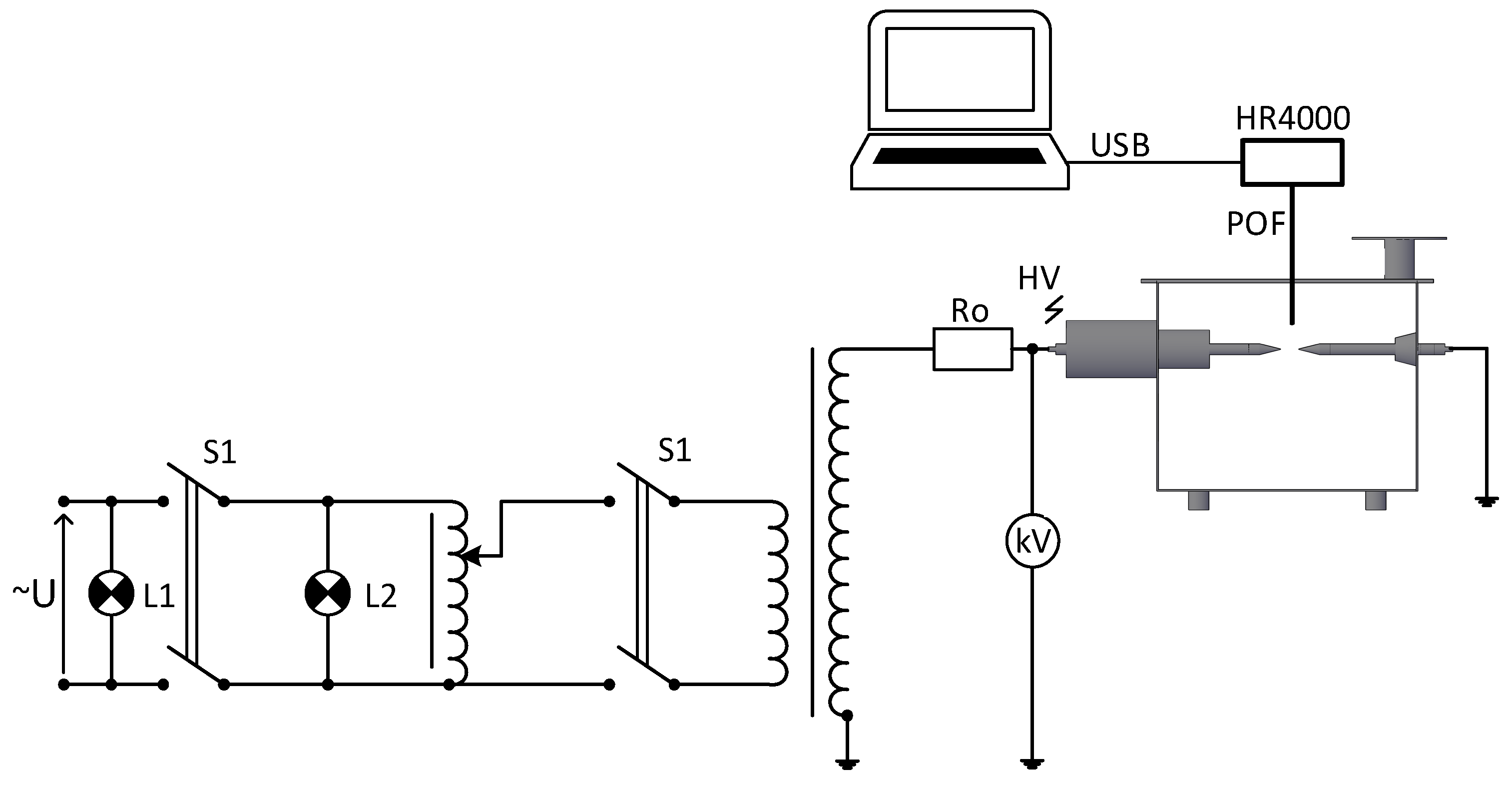

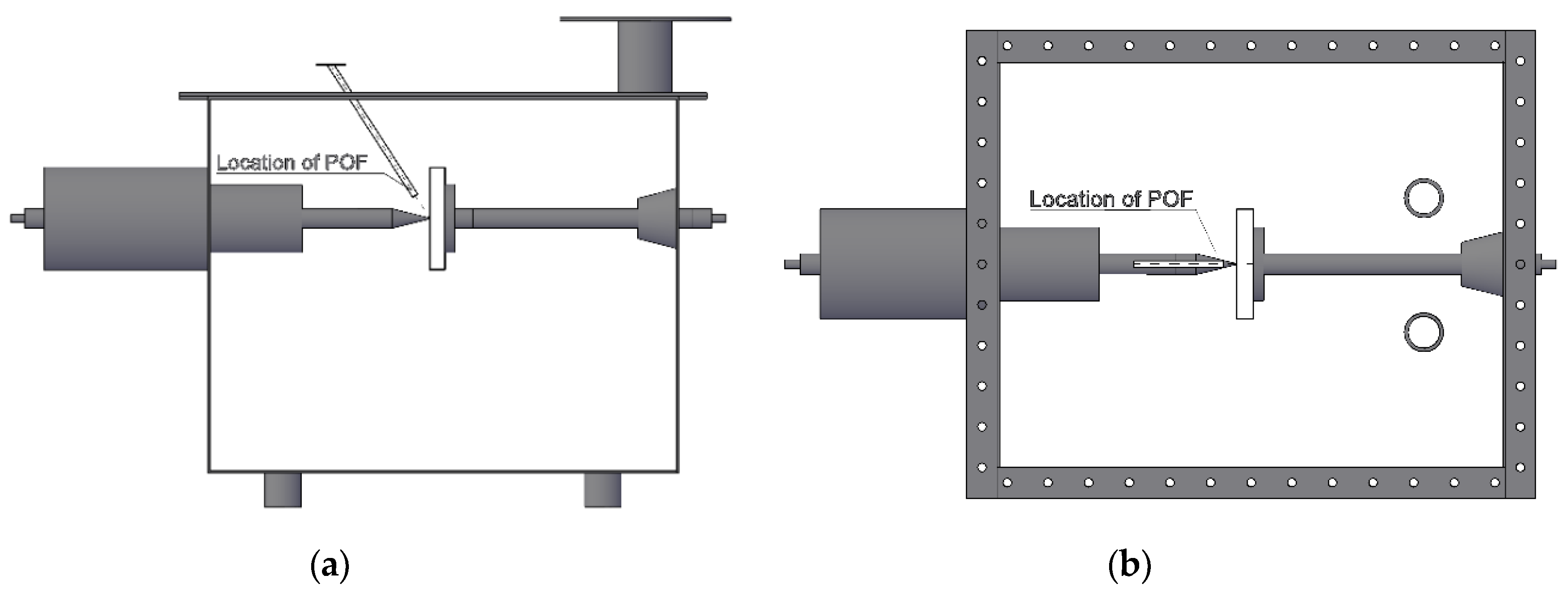

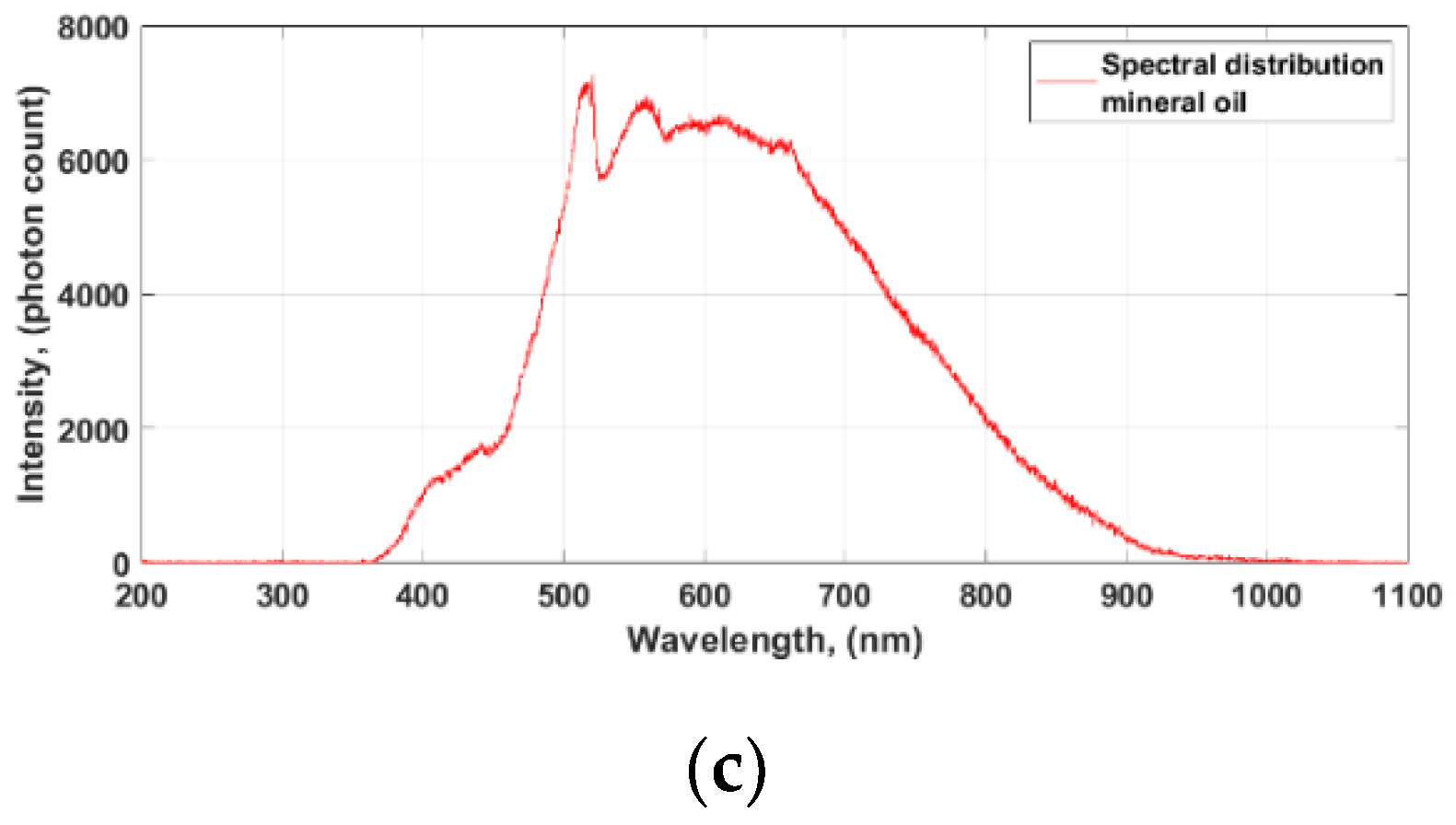

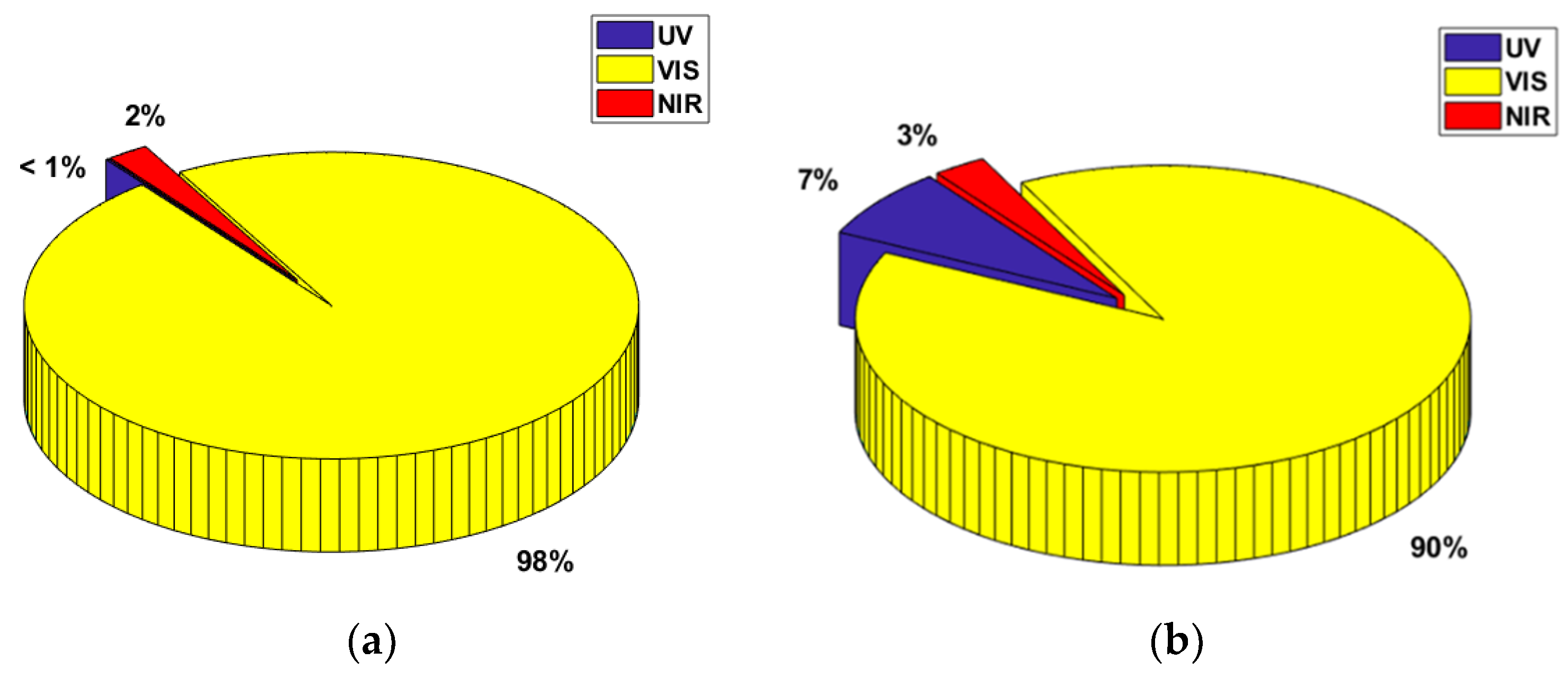
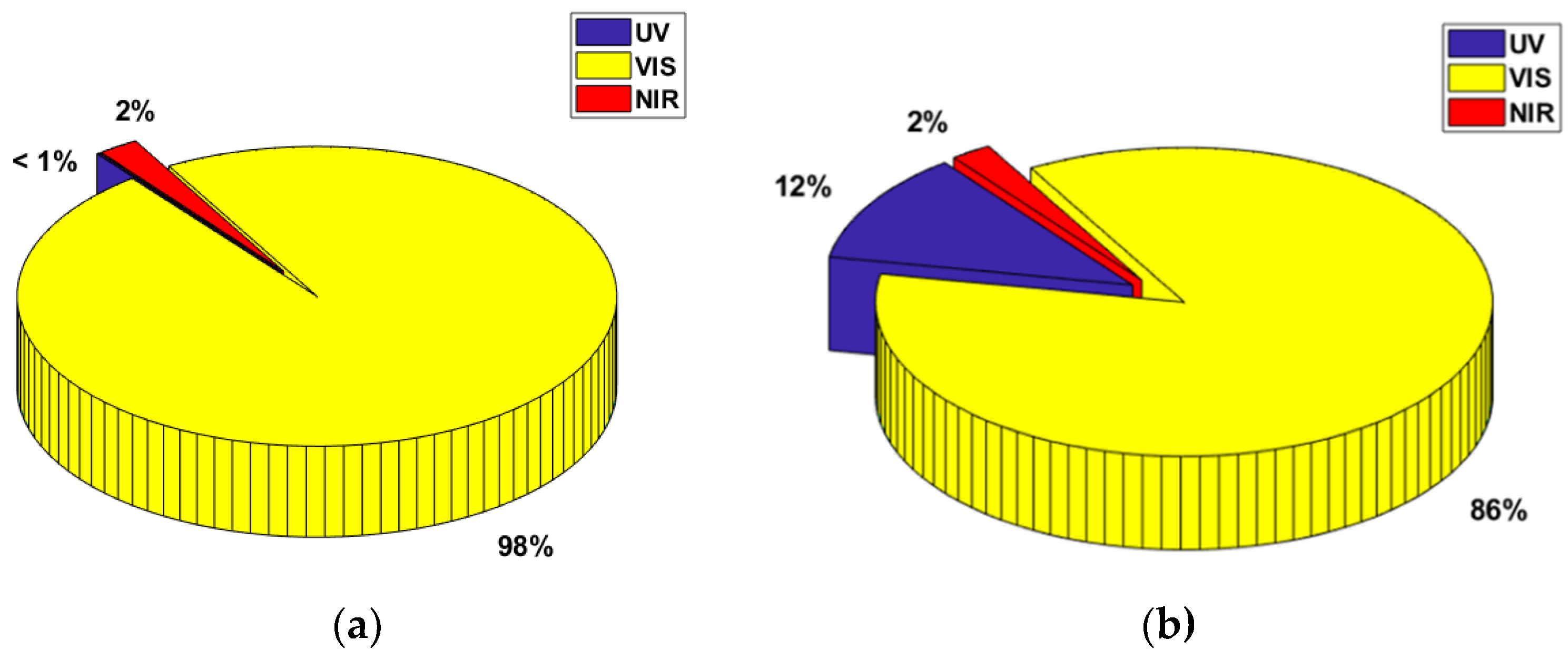
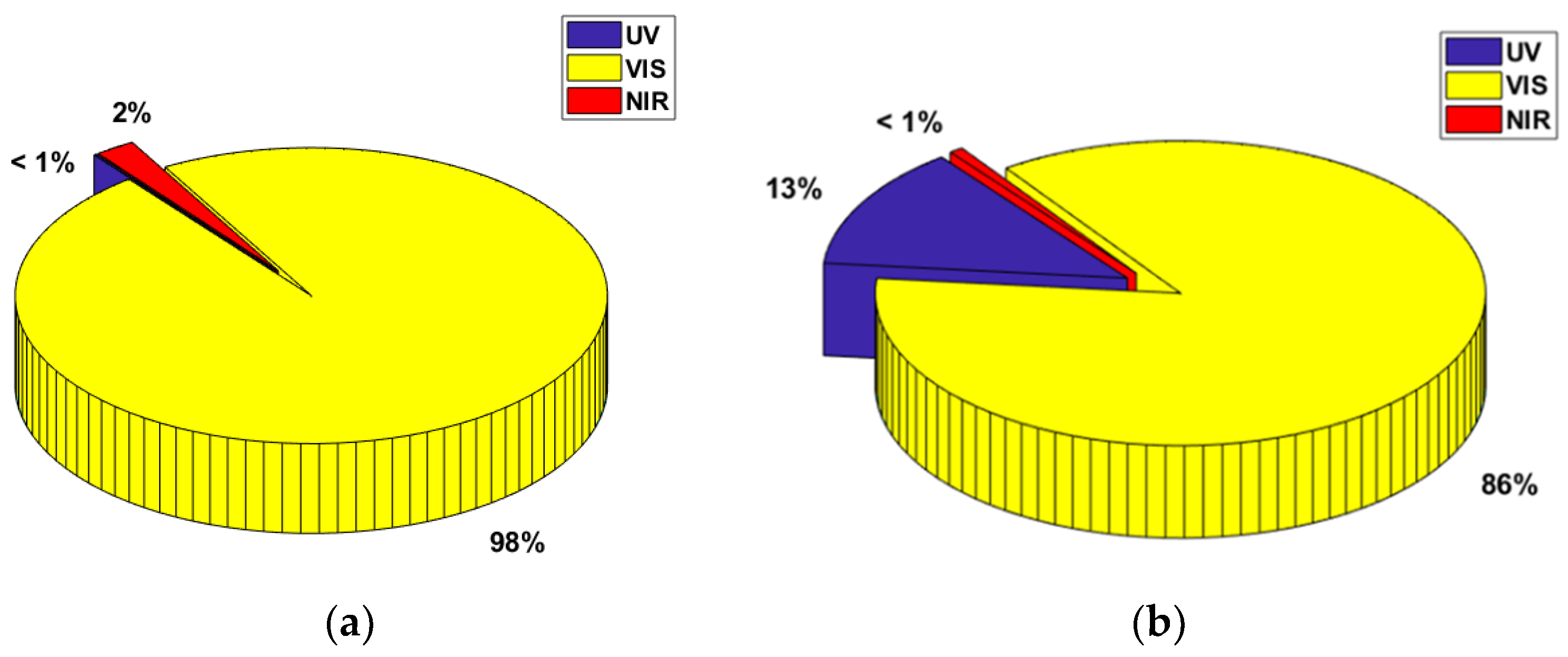
| Parameter | Value |
|---|---|
| spectral range | 200 nm–1100 nm |
| fiber core type | polymer |
| core diameter | 600 ± 10 μm |
| operating temperature range | −65 °C…+300 °C |
| fiber bend radius | 12 cm |
| acceptance angle | 25° |
| Type of Liquid | Energy in UV Range (EUV) 200 nm–380 nm | Energy in VIS Range (EVIS) 380 nm–780 nm | Energy in NIR Range (ENIR) 780 nm–1100 nm | Total Energy (Ec = EUV + EVIS + ENIR) | |
|---|---|---|---|---|---|
| (J) | (J) | (J) | (J) | GeV | |
| needle–needle system | |||||
| natural ester | 6.56 × 10−13 | 9.07 × 10−11 | 2.21 × 10−12 | 9.35 × 10−11 | 0.58 |
| synthetic ester | 2.39 × 10−12 | 1.96 × 10−10 | 4.50 × 10−12 | 2.03 × 10−10 | 1.27 |
| mineral oil | 1.08 × 10−12 | 3.07 × 10−10 | 1.02 × 10−11 | 3.17 × 10−10 | 1.98 |
| surface discharge system | |||||
| natural ester | 9.04 × 10−12 | 8.15 × 10−11 | 3.34 × 10−12 | 9.38 × 10−11 | 0.59 |
| synthetic ester | 1.07 × 10−11 | 1.57 × 10−10 | 1.63 × 10−12 | 1.69 × 10−10 | 1.05 |
| mineral oil | 3.09 × 10−11 | 2.05 × 10−10 | 1.74 × 10−12 | 2.37 × 10−10 | 1.48 |
| Type of Liquid | Range of Optical Radiation | Average Energy (%Ec) | Variance | Standard Deviation | Coefficient of Variation | Range of Typical Values of Radiation Energy Share |
|---|---|---|---|---|---|---|
| s2 | s | Vs | Xtyp | |||
| needle–needle system | ||||||
| Natural ester | UV | 0.70 | 0.01 | 0.06 | 8.57 | 0.64 < Xtyp < 0.76 |
| VIS | 97.60 | 0.62 | 0.79 | 0.81 | 96.81 < Xtyp < 98.39 | |
| NIR | 1.70 | 0.08 | 0.29 | 17.06 | 1.41 < Xtyp < 1.99 | |
| Synthetic ester | UV | 0.50 | 0.02 | 0.15 | 30.00 | 0.35 < Xtyp < 0.65 |
| VIS | 97.90 | 1.13 | 1.06 | 1.08 | 96.84 < Xtyp < 98.96 | |
| NIR | 1.60 | 0.13 | 0.36 | 22.50 | 1.24 < Xtyp < 1.96 | |
| Mineral oil | UV | 0.40 | 0.07 | 0.26 | 65.0 | 0.64 < Xtyp < 0.76 |
| VIS | 97.80 | 0.51 | 0.71 | 0.73 | 97.09 < Xtyp < 98.51 | |
| NIR | 1.80 | 0.03 | 0.16 | 8.89 | 1.64 < Xtyp < 1.96 | |
| surface discharge system | ||||||
| Natural ester | UV | 6.70 | 0.30 | 0.55 | 7.46 | 6.15 < Xtyp < 7.25 |
| VIS | 90.20 | 1.65 | 1.28 | 1.42 | 88.92 < Xtyp < 91.48 | |
| NIR | 3.10 | 0.10 | 0.32 | 10.32 | 2.78 < Xtyp < 3.42 | |
| Synthetic ester | UV | 12.10 | 0.48 | 0.69 | 5.70 | 11.41 < Xtyp < 12.79 |
| VIS | 86.00 | 0.38 | 0.62 | 0.72 | 85.38 < Xtyp < 86.62 | |
| NIR | 1.90 | 0.08 | 0.28 | 14.74 | 1.62 < Xtyp < 2.18 | |
| Mineral oil | UV | 13.00 | 0.10 | 0.32 | 2.46 | 12.68 < Xtyp < 13.32 |
| VIS | 86.30 | 0.10 | 0.31 | 0.36 | 85.99 < Xtyp < 86.61 | |
| NIR | 0.70 | 0.01 | 0.06 | 8.57 | 0.64 < Xtyp < 0.76 | |
© 2020 by the author. Licensee MDPI, Basel, Switzerland. This article is an open access article distributed under the terms and conditions of the Creative Commons Attribution (CC BY) license (http://creativecommons.org/licenses/by/4.0/).
Share and Cite
Kozioł, M. Energy Distribution of Optical Radiation Emitted by Electrical Discharges in Insulating Liquids. Energies 2020, 13, 2172. https://doi.org/10.3390/en13092172
Kozioł M. Energy Distribution of Optical Radiation Emitted by Electrical Discharges in Insulating Liquids. Energies. 2020; 13(9):2172. https://doi.org/10.3390/en13092172
Chicago/Turabian StyleKozioł, Michał. 2020. "Energy Distribution of Optical Radiation Emitted by Electrical Discharges in Insulating Liquids" Energies 13, no. 9: 2172. https://doi.org/10.3390/en13092172
APA StyleKozioł, M. (2020). Energy Distribution of Optical Radiation Emitted by Electrical Discharges in Insulating Liquids. Energies, 13(9), 2172. https://doi.org/10.3390/en13092172





